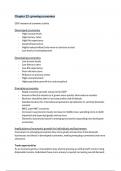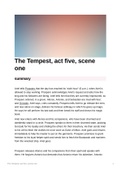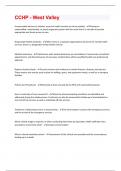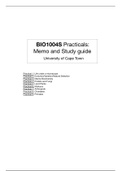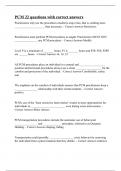Page 1
Introductory Life Sciences (BIOL1000)
APES Notes
, Page 2
Animal Structure and Function – Prof Graham Alexander
The Circulatory System:
↳ Rapid transport system
Functions of the Circulatory System:
1. Nutrient and waste transport:
- Ingestion ➞ digestion ➞ absorption ➞ assimilation ➞ egestion ➞ excretion
2. Oxygen and carbon dioxide transport:
- Oxygen is used by the circulatory system for metabolism
- Carbon dioxide is therefore the byproduct
3. Thermoregulation (physiological):
- Regulation of body temperature is split into two categories:
↳ Physiological and behavioural
4. Hormone control:
- Hormones are transported from the place of manufacture to the location of use by the
circulatory system
5. Body defences:
- The lymphatic system
6. Structural function:
- This occurs in the organs of some organisms, such as roundworms
- It doesn’t apply to mammals as they have bones for structure
, Page 3
Types of Circulatory Systems:
1. No circulatory system:
- i.e. bacterium / flatworms (Platyhelminthes)
- Cells in organisms without a circulatory system rely on diffusion in order to receive
oxygen
- These organisms need to have a large surface area in order for diffusion to take
place and for the oxygen to reach the cells
- The diffused oxygen doesn’t need to diffuse very far because the cells which
are receiving oxygen are relatively close to the surface
2. Unspecialised system:
- i.e. roundworms (coelom / pseudocoelom)
- These organisms are filled with fluid, and they contain muscle cells
- They are thus able to move different molecules around the body quite easily by
contracting the muscle cells
- They also use the fluid as a rudimentary system
- They are able to change their shape due to hydrostatic pressure
3. Specialised, open system:
- i.e. insects, mollusks, sea-squirts and hagfish (which are partially open)
- Vessels run through the bodies of these organisms – the heart contracts and increases
the pressure in those vessels
- The fluid in the heart moves down a pressure gradient
- The vessels are open-ended; meaning that they open into the interstitial space
➢Systems which contain valves are responsible for restricting the direction of the
movement of fluid – sea-squirts do not contain valves; therefore, the direction of
the blood is determined by the contractions of the heart
➢Insect blood does not contain haemoglobin, and they don’t use their circulatory
system to transport oxygen; therefore, they have many airways which direct
oxygen to their cells
, Page 4
4. Specialised, closed, one cycle system:
- i.e. fish / annelids (leaches / earthworms)
- Some organisms, such as annelids, can contain more than one heart which pumps the
blood in one direction
- The blood moves into vessels which then branch off into capillaries
- The capillaries then join to form one big vessel again which further directs the
blood back to the heart
➢These organisms collect oxygen from the body surface via diffusion
- In fish, blood gets pumped out of the heart and it moves to the gills (which are finely
branched vessels)
- Blood and oxygen are then pumped to the different vessels, capillaries and organs
➢When the blood moves into the capillaries, the pressure decreases – there is
friction in vessels, and the surface area in capillaries is greater than that of the
vessels; therefore, there is an increase in friction in the capillaries
➢In organisms with a one-cycle system, the blood pressure is often lower than that of
organisms with a two-cycle system
In closed systems:
- The movement of blood in these organisms is controllable
- These organisms have a high blood pressure
- The pressure differential allows for ultra filtration
5. Specialised, closed, two cycle system:
- i.e. mammals / birds
➢These organisms have lungs instead of gills
- Blood gets pumped out of the heart and goes to the lungs
- The blood gets oxygenated in the lungs, goes back to the heart, and is then
pumped out of the heart again to be sent to different parts of the body
- The blood is pumped out of the heart at a very high pressure
- For every time blood is delivered to the tissues, it has already been to the heart
twice – that is why it is called a ‘two cycle system’
Introductory Life Sciences (BIOL1000)
APES Notes
, Page 2
Animal Structure and Function – Prof Graham Alexander
The Circulatory System:
↳ Rapid transport system
Functions of the Circulatory System:
1. Nutrient and waste transport:
- Ingestion ➞ digestion ➞ absorption ➞ assimilation ➞ egestion ➞ excretion
2. Oxygen and carbon dioxide transport:
- Oxygen is used by the circulatory system for metabolism
- Carbon dioxide is therefore the byproduct
3. Thermoregulation (physiological):
- Regulation of body temperature is split into two categories:
↳ Physiological and behavioural
4. Hormone control:
- Hormones are transported from the place of manufacture to the location of use by the
circulatory system
5. Body defences:
- The lymphatic system
6. Structural function:
- This occurs in the organs of some organisms, such as roundworms
- It doesn’t apply to mammals as they have bones for structure
, Page 3
Types of Circulatory Systems:
1. No circulatory system:
- i.e. bacterium / flatworms (Platyhelminthes)
- Cells in organisms without a circulatory system rely on diffusion in order to receive
oxygen
- These organisms need to have a large surface area in order for diffusion to take
place and for the oxygen to reach the cells
- The diffused oxygen doesn’t need to diffuse very far because the cells which
are receiving oxygen are relatively close to the surface
2. Unspecialised system:
- i.e. roundworms (coelom / pseudocoelom)
- These organisms are filled with fluid, and they contain muscle cells
- They are thus able to move different molecules around the body quite easily by
contracting the muscle cells
- They also use the fluid as a rudimentary system
- They are able to change their shape due to hydrostatic pressure
3. Specialised, open system:
- i.e. insects, mollusks, sea-squirts and hagfish (which are partially open)
- Vessels run through the bodies of these organisms – the heart contracts and increases
the pressure in those vessels
- The fluid in the heart moves down a pressure gradient
- The vessels are open-ended; meaning that they open into the interstitial space
➢Systems which contain valves are responsible for restricting the direction of the
movement of fluid – sea-squirts do not contain valves; therefore, the direction of
the blood is determined by the contractions of the heart
➢Insect blood does not contain haemoglobin, and they don’t use their circulatory
system to transport oxygen; therefore, they have many airways which direct
oxygen to their cells
, Page 4
4. Specialised, closed, one cycle system:
- i.e. fish / annelids (leaches / earthworms)
- Some organisms, such as annelids, can contain more than one heart which pumps the
blood in one direction
- The blood moves into vessels which then branch off into capillaries
- The capillaries then join to form one big vessel again which further directs the
blood back to the heart
➢These organisms collect oxygen from the body surface via diffusion
- In fish, blood gets pumped out of the heart and it moves to the gills (which are finely
branched vessels)
- Blood and oxygen are then pumped to the different vessels, capillaries and organs
➢When the blood moves into the capillaries, the pressure decreases – there is
friction in vessels, and the surface area in capillaries is greater than that of the
vessels; therefore, there is an increase in friction in the capillaries
➢In organisms with a one-cycle system, the blood pressure is often lower than that of
organisms with a two-cycle system
In closed systems:
- The movement of blood in these organisms is controllable
- These organisms have a high blood pressure
- The pressure differential allows for ultra filtration
5. Specialised, closed, two cycle system:
- i.e. mammals / birds
➢These organisms have lungs instead of gills
- Blood gets pumped out of the heart and goes to the lungs
- The blood gets oxygenated in the lungs, goes back to the heart, and is then
pumped out of the heart again to be sent to different parts of the body
- The blood is pumped out of the heart at a very high pressure
- For every time blood is delivered to the tissues, it has already been to the heart
twice – that is why it is called a ‘two cycle system’


